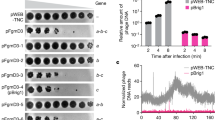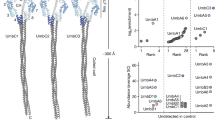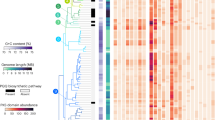Abstract
Streptococcal bacteria use peptide signals as a means of intraspecies communication. These peptides can contain unusual post-translational modifications, providing opportunities for expanding our understanding of nature's chemical and biosynthetic repertoires. Here, we have combined tools from natural products discovery and mechanistic enzymology to elucidate the structure and biosynthesis of streptide, a streptococcal macrocyclic peptide. We show that streptide bears an unprecedented post-translational modification involving a covalent linkage between two unactivated carbons within the side chains of lysine and tryptophan. The biosynthesis of streptide was addressed by genetic and biochemical studies. The former implicated a new SPASM-domain-containing radical SAM enzyme StrB, while the latter revealed that StrB contains two [4Fe–4S] clusters and installs the unusual lysine-to-tryptophan crosslink in a single step. By intramolecularly stitching together the side chains of lysine and tryptophan, StrB provides a new route for biosynthesizing macrocyclic peptides.
This is a preview of subscription content, access via your institution
Access options
Subscribe to this journal
Receive 12 print issues and online access
$259.00 per year
only $21.58 per issue
Buy this article
- Purchase on Springer Link
- Instant access to full article PDF
Prices may be subject to local taxes which are calculated during checkout





Similar content being viewed by others
References
Arnison, P. G. et al. Ribosomally synthesized and post-translationally modified peptide natural products: overview and recommendations for a universal nomenclature. Nat. Prod. Rep. 30, 108–160 (2013).
Trauger, J. W., Kohli, R. M., Mootz, H. D., Marahiel, M. A. & Walsh, C. T. Peptide cyclization catalysed by the thioesterase domain of tyrocidine synthetase. Nature 407, 215–218 (2000).
Duquesne, S. et al. Two enzymes catalyze the maturation of a lasso peptide in Escherichia coli. Chem. Biol. 14, 793–803 (2007).
Dorenbos, R. et al. Thiol-disulfide oxidoreductases are essential for the production of the lantibiotic sublancin 168. J. Biol. Chem. 277, 16682–16688 (2002).
Ziemert, N., Ishida, K., Liaimer, A., Hertweck, C. & Dittmann, E. Ribosomal synthesis of tricyclic depsipeptides in bloom-forming cyanobacteria. Angew. Chem. Int. Ed. 47, 7756–7759 (2008).
Philmus, B., Christiansen, G., Yoshida, W. Y. & Hemscheidt, T. K. Post-translational modification in microviridin biosynthesis. ChemBioChem 9, 3066–3073 (2008).
Ji, G., Beavis, R. & Novick, R. P. Bacterial interference caused by autoinducing peptide variants. Science 276, 2027–2030 (1997).
Mayville, P. et al. Structure–activity analysis of synthetic autoinducing thiolactone peptides from Staphylococcus aureus responsible for virulence. Proc. Natl Acad. Sci. USA 96, 1218–1223 (1999).
Li, B. et al. Structure and mechanism of the lantibiotic cyclase involved in nisin biosynthesis. Science 311, 1464–1467 (2006).
Flühe, L. et al. The radical SAM enzyme AlbA catalyzes thioether bond formation in subtilosin A. Nature Chem. Biol. 8, 350–357 (2012).
Müller, W. M., Schmiederer, T., Ensle, P. & Süssmuth, R. D. In vitro biosynthesis of the prepeptide of type-III lantibiotic labyrinthopeptin A2 including formation of a C–C bond as a post-translational modification. Angew. Chem. Int. Ed. 49, 2436–2440 (2010).
Zerbe, K. et al. An oxidative phenol coupling reaction catalyzed by OxyB, a cytochrome P450 from the vancomycin-producing microorganism. Angew. Chem. Int. Ed. 43, 6709–6713 (2004).
Dunbar, K. L. & Mitchell, D. A. Revealing nature's synthetic potential through the study of ribosomal natural product biosynthesis. ACS Chem. Biol. 8, 473–487 (2013).
Ibrahim, M. et al. Control of the transcription of a short gene encoding a cyclic peptide in Streptococcus thermophilus: a new quorum-sensing system? J. Bacteriol. 189, 8844–8854 (2007).
Fleuchot, B. et al. Rgg proteins associated with internalized small hydrophobic peptides: a new quorum-sensing mechanism in streptococci. Mol. Microbiol. 80, 1102–1119 (2011).
Gardan, R., Besset, C., Guillot, A., Gitton, C. & Monnet, V. The oligopeptide transport system is essential for the development of natural competence in Streptococcus thermophilus strain LMD-9. J. Bacteriol. 191, 4647–4655 (2009).
Lyon, W. R., Gibson, C. M. & Caparon, M. G. A role for trigger factor and an rgg-like regulator in the transcription, secretion and processing of the cysteine proteinase of Streptococcus pyogenes. EMBO J. 17, 6263–6275 (1998).
Chaussee, M. S., Ajdic, D. & Ferretti, J. J. The rgg gene of Streptococcus pyogenes NZ131 positively influences extracellular SPE B production. Infect. Immun. 67, 1715–1722 (1999).
Mashburn-Warren, L., Morrison, D. A. & Federle, M. J. A novel double-tryptophan peptide pheromone controls competence in Streptococcus spp. via an Rgg regulator. Mol. Microbiol. 78, 589–606 (2010).
Fernandez, A., Borges, F., Gintz, B., Decaris, B. & Leblond-Bourget, N. The rggC locus, with a frameshift mutation, is involved in oxidative stress response by Streptococcus thermophilus. Arch. Microbiol. 186, 161–169 (2006).
Qi, F., Chen, P. & Caufield, P. W. Functional analyses of the promoters in the lantibiotic mutacin II biosynthetic locus in Streptococcus mutans. Appl. Environ. Microbiol. 65, 652–658 (1999).
Kawulka, K. E. et al. Structure of subtilosin A, a cyclic antimicrobial peptide from Bacillus subtilis with unusual sulfur to alpha-carbon cross-links: formation and reduction of alpha-thio-alpha-amino acid derivatives. Biochemistry 43, 3385–3395 (2004).
Rea, M. C. et al. Thuricin CD, a posttranslationally modified bacteriocin with a narrow spectrum of activity against Clostridium difficile. Proc. Natl Acad. Sci. USA 107, 9352–9357 (2010).
Sit, C. S., McKay, R. T., Hill, C., Ross, R. P. & Vederas, J. C. The 3D structure of thuricin CD, a two-component bacteriocin with cysteine sulfur to α-carbon cross-links. J. Am. Chem. Soc. 133, 7680–7683 (2011).
Sit, C. S., van Belkum, M. J., McKay, R. T., Worobo, R. W. & Vederas, J. C. The 3D solution structure of thurincin H, a bacteriocin with four sulfur to α-carbon crosslinks. Angew. Chem. Int. Ed. 50, 8718–8721 (2011).
Güntert, P., Mumenthaler, C. & Wüthrich, K. Torsion angle dynamics for NMR structure calculation with the new program DYANA. J. Mol. Biol. 273, 283–298 (1997).
Herrmann, T., Güntert, P. & Wüthrich, K. Protein NMR structure determination with automated NOE-identification in the NOESY spectra using the new software ATNOS. J. Biomol. NMR 24, 171–189 (2002).
Haft, D. H. & Basu, M. K. Biological systems discovery in silico: radical S-adenosylmethionine protein families and their target peptides for posttranslational modification. J. Bacteriol. 193, 2745–2755 (2011).
Haft, D. H. Bioinformatic evidence for a widely distributed, ribosomally produced electron carrier precursor, its maturation proteins, and its nicotinoprotein redox partners. BMC Genomics 12, 21–34 (2011).
Frey, P. A. & Booker, S. J. Radical mechanisms of S-adenosylmethionine-dependent enzymes. Adv. Protein Chem. 58, 1–45 (2001).
Booker, S. J. Anaerobic functionalization of unactivated C–H bonds. Curr. Opin. Chem. Biol. 13, 58–73 (2009).
Broderick, J. B., Duffus, B. R., Duschene, K. S. & Shepard, E. M. Radical S-adenosylmethionine enzymes. Chem. Rev. 114, 4229–4317 (2014).
Fang, Q., Peng, J. & Dierks, T. Post-translational formylglycine modification of bacterial sulfatases by the radical S-adenoyslmethionine protein AtsB. J. Biol. Chem. 279, 14570–14578 (2004).
Berteau, O., Guillot, A., Benjdia, A. & Rabot, S. A new type of bacterial sulfatase reveals a novel maturation pathway in prokaryotes. J. Biol. Chem. 281, 22464–22470 (2006).
Benjdia, A. et al. Anaerobic sulfatase-maturating enzymes: radical SAM enzymes able to catalyze in vitro sulfatase post-translational modification. J. Am. Chem. Soc. 129, 3462–3463 (2007).
Grove, T. L., Lee, K. H., St Clair, J., Krebs, C. & Booker, S. J. In vitro characterization of AtsB, a radical SAM formylglycine-generating enzyme that contains three [4Fe–4S] clusters. Biochemistry 47, 7523–7538 (2008).
Grove, T. L. et al. Further characterization of Cys-type and Ser-type anaerobic sulfatase maturating enzymes suggests a commonality in the mechanism of catalysis. Biochemistry 52, 2874–2887 (2013).
Goldman, P. J. et al. X-ray structure of an AdoMet radical activase reveals an anaerobic solution for formylglycine posttranslational modification. Proc. Natl Acad. Sci. USA 110, 8519–8524 (2013).
Lanz, N. D. et al. RlmN and AtsB as models for the overproduction and characterization of radical SAM proteins. Methods Enzymol. 516, 125–152 (2012).
Johnson, D. C., Unciuleac, M. C. & Dean, D. R. Controlled expression and functional analysis of iron–sulfur cluster biosynthetic components within Azotobacter vinelandii. J. Bacteriol. 188, 7551–7561 (2006).
Wecksler, S. R. et al. Pyrroloquinoline quinon biogenesis: demonstration that PqqE from Klebsiella pneumoniae is a radical S-adenosyl-L-methionine enzyme. Biochemistry 48, 10151–10161 (2009).
Goldman, P. J., Grove, T. L., Booker, S. J. & Drennan, C. L. X-ray analysis of butirosin biosynthetic enzyme BtrN redefines structural motifs for AdoMet radical chemistry. Proc. Natl Acad. Sci. USA 110, 15949–15954 (2013).
Flühe, L. et al. Two [4Fe–4S] clusters containing radical SAM enzyme SkfB catalzye thioether bond formation during the maturation of the sporulation killing factor. J. Am. Chem. Soc. 135, 959–962 (2013).
Oman, T. J. & van der Donk, W. A. Follow the leader: the use of leader peptides to guide natural product biosynthesis. Nature Chem. Biol. 6, 9–18 (2010).
Wu, W., Lieder, K. W., Reed, G. H. & Frey, P. A. Observation of a second substrate radical intermediate in the reaction of lysine 2,3-aminomutase: a radical centered on the beta-carbon of the alternative substrate, 4-thia-L-lysine. Biochemistry 34, 10532–10537 (1995).
Ruszczycky, M. W., Choi, S. H. & Liu, H. W. Stoichiometry of the redox neutral deamination and oxidative dehydrogenation reactions catalzyed by the radical SAM enzyme DesII. J. Am. Chem. Soc. 132, 2359–2369 (2010).
Grove, T. L., Ahlum, J. H., Sharma, P., Krebs, C. & Booker, S. J. A consensus mechanism for radical SAM-dependent dehydrogenation? BtrN contains two [4Fe–4S] clusters. Biochemistry 49, 3783–3785 (2010).
Mitchell, J. Streptococcus mitis: walking the line between commensalism and pathogenesis. Mol. Oral Microbiol. 26, 89–98 (2011).
Le Doare, K. & Heath, P. T. An overview of global GBS epidemiology. Vaccine 31, D7–D12 (2013).
Fittipaldi, N., Segura, M., Grenier, D. & Gottschalk, M. Virulence factors involved in the pathogenesis of the infection caused by the swine pathogen and zoonotic agent Streptococcus suis. Future Microbiol. 7, 259–279 (2012).
Acknowledgements
The authors thank P. Güntert and H. Arthanari for invaluable advice on CYANA, I. Pelczer and K. Connover at the Princeton Chemistry NMR facility for assistance with NMR data acquisition, S. Booker for the gift of pDB1282, K. Shatalin for the gift of pKS1, and Z. Brown for advice regarding peptide synthesis. This work was supported by the National Institutes of Health (grant no. GM098299, to M.R.S.) and by Princeton University start-up funds.
Author information
Authors and Affiliations
Contributions
K.R.S., L.B.B. and M.R.S. designed and executed experiments, and analysed data. M.R.S. conceived of the project and wrote the manuscript.
Corresponding author
Ethics declarations
Competing interests
The authors declare no competing financial interests.
Supplementary information
Supplementary information
Supplementary information (PDF 4010 kb)
Rights and permissions
About this article
Cite this article
Schramma, K., Bushin, L. & Seyedsayamdost, M. Structure and biosynthesis of a macrocyclic peptide containing an unprecedented lysine-to-tryptophan crosslink. Nature Chem 7, 431–437 (2015). https://doi.org/10.1038/nchem.2237
Received:
Accepted:
Published:
Issue Date:
DOI: https://doi.org/10.1038/nchem.2237
This article is cited by
-
A new class of macrocyclic peptides
Nature Chemical Biology (2024)
-
Modular synthesis of clickable peptides via late-stage maleimidation on C(7)-H tryptophan
Nature Communications (2023)
-
Discovery and biosynthesis of tricyclic copper-binding ribosomal peptides containing histidine-to-butyrine crosslinks
Nature Communications (2023)
-
Bicyclostreptins are radical SAM enzyme-modified peptides with unique cyclization motifs
Nature Chemical Biology (2022)
-
RiPP-ing through the plant kingdom
Nature Chemical Biology (2022)



